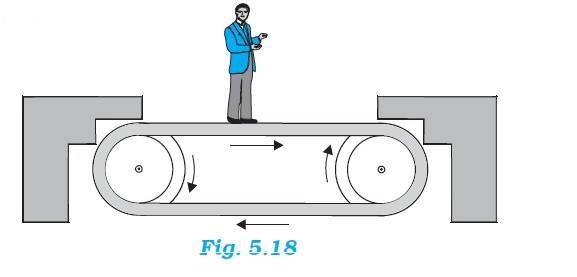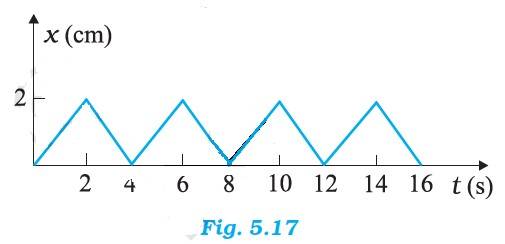Laws of Motion
Get insights from 109 questions on Laws of Motion, answered by students, alumni, and experts. You may also ask and answer any question you like about Laws of Motion
Follow Ask QuestionQuestions
Discussions
Active Users
Followers
New answer posted
6 months agoContributor-Level 10
Given
Radius, r = 30m
Speed, v = 54 km/h = 15 m/s
The mass of the train, m = 106 kg
(a) The required centripetal force is provided by the rails to the wheels of the train
(b) The angle of banking required to prevent wearing out of the rails
= / rg = / (30
= 37
New answer posted
6 months agoContributor-Level 10
The speed of the aircraft, v = 720 km/h = 200 m/s
The angle of banking = 15
From the relation = /rg we get r = / ( g = 14928 m
New answer posted
6 months agoContributor-Level 10
(a) The force on the 7th coin is due to the 3 coins kept above it The weight of the 3 coins = 3m Force exerted on the 7th coin is (3mg) N and the force is acting vertically downwards (b) The force on the 7th coin by the 8th coin will be the force exerted by the 3 coins above it = (3mg) N, acting downwards (c) The 6th coin will experience the force of 4 coins above it, acting downwards = 4mg |
New answer posted
6 months agoContributor-Level 10
Speed of water, v = 15 m/s
Cross-sectional area of the tube, A = 10-2 m2
Density of water = 1000 kg/m3
Mass of the water hitting the wall = = 1000 10-2 = 150 kg/s
Force exerted on the wall because of impact of water = mass velocity = 150 N = 2250 N
New answer posted
6 months agoContributor-Level 10
Given
Mass of the helicopter m1 = 1000 kg
Mass of the crew and passenger m2 = 300 kg
The vertical acceleration of the helicopter, a = 15 m/s2 and acceleration due to gravity g = 10 m/s2
The total mass of the system, m = m1 + m2 = 1000 + 300 = 1300 kg
(a) Force on the floor by the crew and passengers :
R – m2g =m2a
R = m2 (g+a) = 300 ( 10 + 15 ) N = 7500 N
(b) Action of the rotor of the helicopter on the surrounding air
R' – mg = ma
R' = m (g+a) = 1300 = 32500 N
(c) Force on the helicopter due to the surrounding air
It is the reaction of the force applied by the rotor on the air. As action and reaction are
New answer posted
6 months agoContributor-Level 10
The net force at the lowest point is denoted by (mg – T1)and the net force at the highest point is denoted by (mg + T2 ), hence option (a) is correct. The forces mg and T1 are in mutually opposite direction at the lowest point and mg and T2 are in the same direction at the highest point.
New answer posted
6 months agoContributor-Level 10
The acceleration of the conveyer belt, a = 1 m/s2
Coefficient of static friction, = 0.2
Mass of the man, m = 65 kg
The net force experienced by the man, MA = 1 N = 65 N
This net force is due to the friction between the belt and the man
At maximum static friction
= = 0.2 m/s2
New answer posted
6 months agoContributor-Level 10
This graph could be of a ball rebounding between two walls separated by a distance of 2 cm.
The ball rebounds every 2 secs between the walls with uniform velocity.
Velocity of rebounding = displacement / time = ( 2 )/2 = 0.01 m/s
Initial momentum = mu = 0.04 4 kgm/s
Final momentum = -mu = -4 kgm/s
Magnitude of Impulse = Initial momentum – final momentum = 8 kgm/s
The time between two consecutive impulses is 2 secs, so the ball receives an impulse every 2 seconds.
New answer posted
6 months agoContributor-Level 10
(a) A horse can pull a cart by the reaction force generated by the ground to its feet. In an empty space, no reaction force will be generated and it cannot pull a cart.
(b) During the movement of the bus, passenger's whole body experiences the inertia of motion of the bus. When a bus brakes, the lower part comes to stand still along with the bus but the upper part continues with the same inertia of motion.
(c) While pulling a lawn mower, the vertical component of the applied force acts upwards and it reduces the effective weight of the lawn mower, make it easy to operate. In case of pushing the lawn mower, the vertical com
New answer posted
6 months agoContributor-Level 10
(a) & (c) solution not possible as the stone will fly off tangentially. The answer is (b)
Taking an Exam? Selecting a College?
Get authentic answers from experts, students and alumni that you won't find anywhere else
Sign Up on ShikshaOn Shiksha, get access to
- 65k Colleges
- 1.2k Exams
- 679k Reviews
- 1800k Answers


